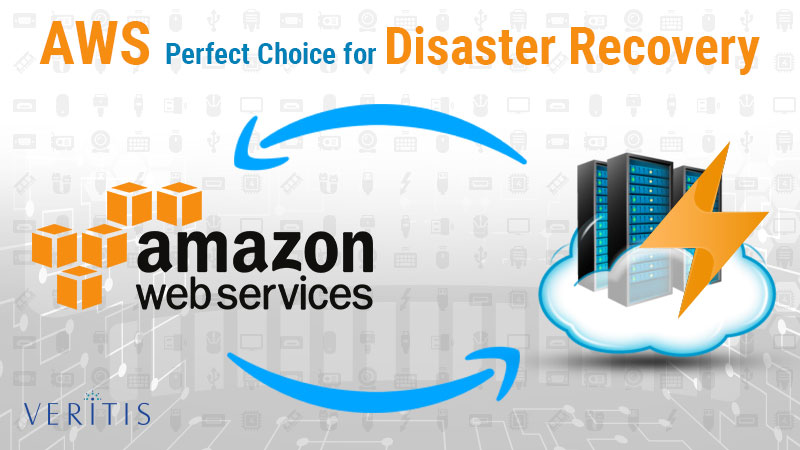
Unexpected disasters that can led to business and product loss is one key aspect that every IT firm is worried about in today’s world! This has given rise to the concept of Disaster Recovery (DR) that helps you with an alternative to store and restore at times of uneven disasters that may cause loss of infrastructure, plans and data.
While there are many DR strategy initiatives in the market, Amazon Web Services (AWS) is one strategy that most firms look at as an investor-friendly option with ease in services.
Always-ready and standby options, along with ease in access, minimized dependence on critical hardware and immediate launch of services on cloud ensuring business continuity are some key features that make AWS cloud an effective DR strategy.
With highly-secure and reliable support, AWS offers its customers flexibility to utilize services as and when needed on a pay-as-you-go basis supported by a robust infrastructure that Amazon uses for its network of websites, globally.
Let’s see what difference Amazon AWS Disaster Recovery (DR) actually makes from the traditional DR solutions!
Traditional Vs Amazon AWS Disaster Recovery
Traditional DR strategies basically move multiple stages of off-site duplication of the existing data and critical infrastructure by setting up, maintaining and testing key business services on the same platform.
However, these strategies tend to be more prone to disasters because of the less distance they maintain between the DR environment and the source location.
A duplicate environment in case of a traditional approach typically demands:
- Additional infrastructure support that need energy support
- Strong security for physical data protection
- Sustained internet and supporting bandwidth facilities
- Enhanced server capacity to run server-critical operations
- Cost-effective network infrastructure for robust network maintenance
These demands result in high expenditure costs making ‘recovery from disaster’ equally costlier to what it makes for setting up a new infrastructure facility. However, AWS plays the game all in a different way!
Also Read: Disaster Recovery – No More A Budgetary Constraint with Cloud
Usage of AWS for Disaster Recovery gives you various benefits. Some of them include:
- Performance: AWS offers quicker storage facilities and equally-quicker access and restore options.
- All on Cloud: Unlike the traditional approach, AWS deals away with tapes and facilitates a full-cloud environment, eliminating transportation, storing and retrieving costs.
- Flexibility: AWS offers flexibility to add vast volumes of data easily and quickly, which can also be managed without the requirement of critical media.
- Benchmark Standards: AWS maintains industry’s benchmark standards supported by the recognized audits and certifications that make them globally-compliant.
- Efficient Backup: Amazon’s cloud computing web service, Amazon S3, is an ideal back up destination offering 99.999999999% percent durability of objects backed up. AWS also facilitates easy transfer of large data sets.
- Easy Recovery: A warm standby solution in AWS decreases the recovery process by keeping some processes continuously running. With this, one can have their critical business systems easily duplicated and have them on all the time.
- Effective Handling: Its needful to scale up systems quickly to handle the production load at times of disaster. AWS eases this process by facilitating the addition of more instances to the load balancer through resizing of small capacity servers to fit in larger Elastic Compute Cloud (EC2) instance types.
- Testing: Working on a duplicate environment to test scenarios at times of failover to Disaster Recovery environment is easier with AWS in terms of cost-effectiveness and speed, without even touching the production environment
- Monitoring: AWS has effective monitoring solutions that can notify you in case of any unexpected behavior of your system. One can easily set alarms depending on the defined thresholds on any of the available metrics.
- User Access: AWS’ Identity and Access Management (IAM) makes it easy to secure access to resources on the DR environment. This helps you differentiate user responsibilities while working on DR environment.
- Automation: Automating the application deployment in AWS-based servers is easy with configuration management software. You can easily handle configuration management and applications across the actual and duplicate environments.

Here are some success stories of using AWS:
- Firms using AWS report overall performance improvement by more than five times
- Many firms report a five-fold drop in their average response time with AWS
- Efficient upfront cost-savings compared to using traditional hardware-based infrastructure
List not exhaustive! AWS can provide many effective flexible and cost-effective solutions as part of your disaster recovery strategy, in line with your budgets. No doubt, you can move ahead with AWS as disaster recovery solution over traditional DR approaches.
Similar: